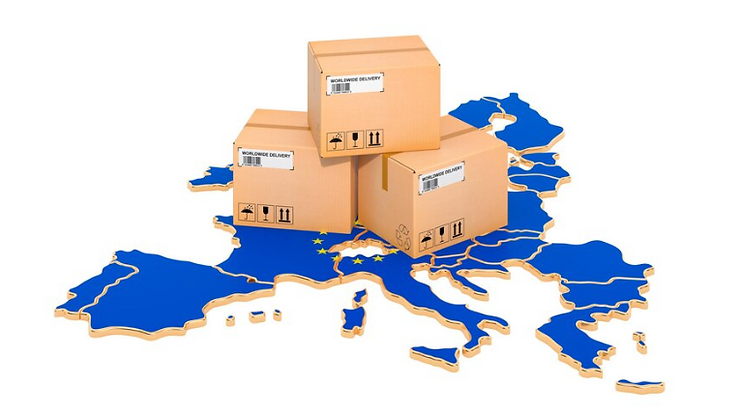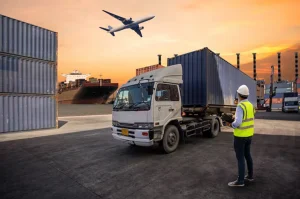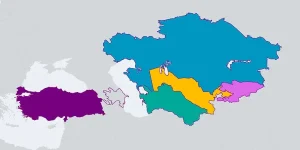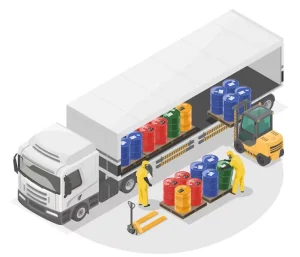How to ship goods from Europe to Uzbekistan, Kyrgyzstan, and Kazakhstan? Efficient logistics play a pivotal role in today’s interconnected global marketplace. Shipping to these Central Asian countries requires careful planning and execution to ensure smooth delivery. With diverse challenges such as varying regulations, long distances, and cultural differences, businesses need a comprehensive strategy to navigate these complexities effectively.
What should be taken into account?
When shipping goods from Europe to Central Asian countries, several critical factors should be taken into account to ensure a smooth and efficient transportation process. Here’s a comprehensive list of considerations:
Regulatory Compliance: Familiarize yourself with the import/export regulations, customs procedures, and documentation requirements of the destination countries in Central Asia (such as Uzbekistan, Kyrgyzstan, and Kazakhstan). Ensure that all necessary permits, licenses, and certifications are obtained before shipping.
Transportation Mode: Choose the most suitable transportation mode based on factors such as the nature of the goods, budget constraints, transit time requirements, and infrastructure availability. Options include air freight, sea freight, rail freight, and road transportation.
Transit Time: Consider the urgency of the shipment and select a transportation mode that offers an appropriate transit time. Balance the need for speed with cost-effectiveness to optimize the overall shipping process.
Cost Analysis: Evaluate the total cost of shipping, including transportation fees, customs duties, taxes, insurance, and any additional charges. Compare quotes from different freight forwarders or carriers to identify the most cost-effective option.
Packaging and Labeling: Ensure that the goods are properly packaged and labeled according to international shipping standards and the specific requirements of the destination countries. Use durable packaging materials to protect the cargo from damage during transit.
Cargo Insurance: Consider obtaining cargo insurance to protect against potential risks such as theft, damage, or loss during transportation. Verify the coverage limits, exclusions, and claim procedures of the insurance policy.
Customs Clearance: Prepare all necessary documentation, including commercial invoices, packing lists, certificates of origin, and import/export permits, in compliance with customs regulations. Work closely with customs brokers or freight forwarders to facilitate smooth customs clearance at both the origin and destination.
Route Planning: Choose the most efficient shipping route based on factors such as distance, transit time, infrastructure, and geopolitical stability. Consider alternative routes or transportation modes to mitigate risks and avoid potential disruptions.
Security Measures: Implement appropriate security measures to protect the cargo against theft, tampering, or unauthorized access during transit. Utilize tracking and monitoring technologies to maintain visibility and control over the shipment.
Communication and Coordination: Establish clear communication channels with all parties involved in the shipping process, including suppliers, carriers, customs brokers, and customers. Maintain regular updates and coordinate closely to address any issues or changes promptly.
By carefully considering these factors and proactively addressing potential challenges, businesses can streamline the shipping process and ensure timely and reliable delivery of goods from Europe to Central Asia. Collaboration with experienced logistics partners and adherence to best practices in international trade can further enhance the efficiency and effectiveness of the supply chain.
Transportation modes
When shipping goods from Europe to Central Asia, businesses have several transportation modes to choose from, each with its own advantages and considerations. Here are the primary transportation modes commonly used for shipping goods to Central Asia:
Air Freight:
Speed: Air freight is the fastest mode of transportation, making it ideal for time-sensitive shipments.
Reliability: Airlines operate frequent flights to major airports in Central Asia, providing reliable and consistent service.
Accessibility: Airports in Central Asian countries like Tashkent (Uzbekistan), Bishkek (Kyrgyzstan), and Almaty (Kazakhstan) are well-connected to international air cargo networks.
Cost: Air freight tends to be more expensive compared to other modes, especially for bulky or heavy cargo.
Cargo Restrictions: Some goods may be subject to restrictions or limitations when shipped by air, particularly hazardous materials or oversized items.
Sea Freight:
Cost-Effectiveness: Sea freight is often more economical for shipping large volumes of goods, particularly non-urgent cargo.
Capacity: Ocean vessels can accommodate bulky or oversized cargo that may not be feasible for air transportation.
Transit Time: Sea freight typically has longer transit times compared to air freight, ranging from several weeks to a few months, depending on the shipping route.
Port Accessibility: Central Asian countries are landlocked, so sea freight shipments typically arrive at nearby seaports in countries like Russia or Iran before being transported overland.
Customs Clearance: Customs clearance procedures at seaports and land borders may add additional time and complexity to the shipping process.
Rail Freight:
Transit Time: Rail freight offers a good balance between speed and cost, with transit times typically ranging from two to three weeks for shipments from Europe to Central Asia.
Cost-Effectiveness: Rail freight can be more cost-effective than air freight while offering faster transit times compared to sea freight.
Infrastructure: Initiatives like the New Silk Road have improved rail infrastructure and connectivity between Europe and Central Asia, making rail freight a viable option for many businesses.
Capacity: Rail freight can handle a wide range of cargo types, including containers, bulk cargo, and temperature-sensitive goods.
Customs Procedures: Customs clearance procedures at border crossings may vary depending on the specific rail route and the countries involved.
Road Transportation:
Flexibility: Road transportation offers flexibility in terms of routes and delivery schedules, making it suitable for shipments to remote or less accessible areas.
Regional Connectivity: Central Asia has an extensive road network, facilitating overland transportation within the region and to neighboring countries.
Transit Time: Road transportation can be faster than sea freight but slower than air or rail freight, depending on the distance and road conditions.
Customs Procedures: Border crossings may involve customs inspections and paperwork, which can affect transit times and lead to delays.
Choosing the most suitable transportation mode depends on factors such as the nature of the goods, budget constraints, transit time requirements, and logistical considerations. Many businesses opt for a multimodal approach, combining different transportation modes to optimize cost, speed, and reliability for their shipments to Central Asia.
The best routes to ship from Europe to Central Asian countries like Kazakhstan, Kyrgyzstan, and Uzbekistan
Determining the best routes to ship goods from Europe to Central Asia, specifically Kazakhstan, Uzbekistan, and Kyrgyzstan, involves considering various factors such as distance, transit time, infrastructure, cost, and accessibility. Here are some commonly used routes for shipping goods from Europe to these Central Asian countries:
Via Georgia:
Rail Freight: Georgia serves as a gateway for rail freight moving between Europe and Central Asia via the Trans-Caspian corridor. Freight trains travel from Europe through Turkey and Georgia, crossing the Caspian Sea by ferry, to reach ports in Azerbaijan (e.g., Baku). From Azerbaijan, cargo can continue by rail to Central Asian countries such as Kazakhstan, Uzbekistan, and Kyrgyzstan.
Sea Freight: Goods can be shipped by sea to the Port of Poti on the eastern coast of the Black Sea. From Poti, cargo can be transshipped onto rail or road transport for further transit to the Central Asian countries. Another option is the Port of Batumi, also located on the Black Sea coast. Batumi handles various types of cargo, including containers, bulk, and general cargo. Goods arriving at Batumi can be transported inland via rail or road to reach Central Asian destinations.
Road Transportation: Georgia has a network of modern highways and roadways that provide access to neighboring countries in the Caucasus and Central Asia. Goods transported by road from Europe can enter Georgia through land borders with Turkey or Azerbaijan and continue onward to Central Asian countries.
Via China:
Rail Freight: With the development of the China-Europe rail network, some shipments from Europe to Central Asia may pass through China. Freight trains travel from European cities to Chinese cities such as Chengdu, Xi’an, or Urumqi, where cargo can be transshipped onto trains bound for Central Asian destinations. This route offers efficient transit times and connectivity to Central Asian markets.
Road Transportation: Goods can also be transported by road from China to Central Asia, crossing the border at various land crossings. While road transportation offers flexibility, it may involve longer transit times and logistical challenges compared to rail freight.
Via Turkey:
Sea Freight: Goods can be shipped to Turkish seaports on the Mediterranean Sea (e.g., Istanbul, Mersin) or the Black Sea (e.g., Istanbul, Trabzon). Cargo originating in Turkey can be transported via land routes, utilizing either road or rail networks, to reach Central Asian countries through neighboring nations such as Iran or Azerbaijan. This route provides access to European and Asian markets and may offer cost-effective shipping options.
Multimodal Routes:
Combination of Modes: Some shipments may benefit from a multimodal approach, combining different transportation modes to optimize cost, speed, and reliability. As an illustration, commodities might be transported via maritime routes to a transshipment center located in either the Middle East or Eastern Europe, before being conveyed by rail or road to Central Asia.
Toptrans: Your Trusted Partner
With 8+ years of industry expertise, Toptrans stands out as a trusted partner for international shipping needs. Our comprehensive range of services, including land, sea, air, and rail transportation, ensures flexibility and reliability for shipments to Uzbekistan, Kyrgyzstan, and Kazakhstan.
What do we offer?
Sea Freight Services:
Our sea freight services offer a cost-effective solution for shipping large-volume goods to Central Asia. With regular sailings and strategic partnerships with leading ocean carriers, we facilitate the smooth transit and delivery of your cargo.
Land Transportation Services:
Toptrans offers comprehensive land transportation services for shipments to Central Asia. Whether it’s through trucking or rail, we provide reliable and secure transportation solutions, leveraging our extensive network and expertise in overland logistics.
Customs Clearance and Brokerage Services:
Navigating customs regulations can be complex, but with Toptrans, you can rely on our experienced customs brokerage team to handle all documentation and compliance requirements efficiently. We ensure smooth customs clearance for your shipments, minimizing delays and ensuring compliance with regulations.
Special Cargo Handling:
From hazardous materials to oversized or bulky shipments, Toptrans specializes in handling various types of special cargo. Our team is trained and equipped to handle such shipments safely and compliantly, ensuring the secure transportation of your goods to Central Asia.
Insurance Coverage Options:
To provide added security and peace of mind, Toptrans offers insurance coverage options for your shipments. Our team can advise you on the available insurance options based on your cargo and specific requirements, ensuring comprehensive protection throughout the shipping process.
Real-time Tracking Systems:
With our advanced tracking systems, you can monitor the status of your shipment in real-time. From pickup to delivery, you’ll receive regular updates on the whereabouts of your cargo, allowing you to stay informed every step of the way.
Dedicated Customer Service:
At Toptrans, we prioritize customer satisfaction and are committed to providing exceptional service. Our dedicated customer service team is available to assist you at every stage of the shipping process, whether you have questions, need assistance, or require a quote for your shipment to Central Asia.
Shipping goods from Europe to Uzbekistan, Kyrgyzstan, and Kazakhstan requires careful planning, expertise, and a reliable logistics partner. With Toptrans, businesses and individuals can enjoy seamless shipping solutions, backed by 8+ years of industry experience, a diverse fleet, and a commitment to excellence. Trust Toptrans to deliver your cargo safely and efficiently to its destination.








